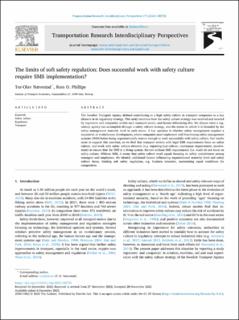| dc.contributor.author | Nævestad, Tor-Olav | |
| dc.contributor.author | Phillips, Ross Owen | |
| dc.coverage.spatial | Norway, Oslo | en_US |
| dc.date.accessioned | 2023-06-14T06:40:00Z | |
| dc.date.available | 2023-06-14T06:40:00Z | |
| dc.date.created | 2022-12-07T17:03:54Z | |
| dc.date.issued | 2022-12-06 | |
| dc.identifier.citation | Transportation Research Interdisciplinary Perspectives (TRIP). 2022, 17 (January), 1-12. | en_US |
| dc.identifier.issn | 2590-1982 | |
| dc.identifier.uri | https://hdl.handle.net/11250/3071255 | |
| dc.description | Published by Elsevier Ltd. This is an open access article under the CC BY license (http://creativecommons.org/licenses/by/4.0/). | en_US |
| dc.description.abstract | The Swedish Transport Agency defined contributing to a high safety culture in transport companies as a key element in its regulatory strategy. This study examines how the safety culture strategy was received and enacted by regulators and companies within each transport sector, and factors influencing this. We discuss what a regulatory agency can accomplish through a safety culture strategy, and the extent to which it is bounded by the safety management maturity level in each sector. A key question is whether safety management requires a sequential, or evolutionary development, where companies must implement well-functioning safety management systems (SMS) before being organisationally mature enough to work successfully with safety culture. Our results seem to support this assertion, as we find that transport sectors with legal SMS requirements focus on safety culture, and work with safety culture elements (e.g. reporting/just culture, continuous improvement, involvement) to ensure that the SMS is a living system. Sectors without SMS requirements (i.e. road) do not focus on safety culture. Without SMS, it seems that safety culture work equals focusing on safety commitment among managers and employees. We identify additional factors influencing organisational maturity level and safety culture focus, limiting soft safety regulation, e.g. business structure, maintaining equal conditions for competition. | en_US |
| dc.description.abstract | The limits of soft safety regulation: Does successful work with safety culture require SMS implementation? | en_US |
| dc.language.iso | eng | en_US |
| dc.publisher | Elsevier Ltd | en_US |
| dc.subject | Safety culture | en_US |
| dc.subject | Regulation | en_US |
| dc.subject | Transport | en_US |
| dc.title | The limits of soft safety regulation: Does successful work with safety culture require SMS implementation? | en_US |
| dc.title.alternative | The limits of soft safety regulation: Does successful work with safety culture require SMS implementation? | en_US |
| dc.type | Journal article | en_US |
| dc.type | Peer reviewed | en_US |
| dc.rights.holder | © 2022 The Authors. | en_US |
| dc.source.articlenumber | 100733 | en_US |
| dc.description.version | publishedVersion | en_US |
| cristin.ispublished | true | |
| cristin.fulltext | original | |
| cristin.qualitycode | 1 | |
| dc.identifier.doi | 10.1016/j.trip.2022.100733 | |
| dc.identifier.cristin | 2090320 | |
| dc.source.journal | Transportation Research Interdisciplinary Perspectives (TRIP) | en_US |
| dc.source.volume | 17 | en_US |
| dc.source.issue | January | en_US |
| dc.source.pagenumber | 1-12 | en_US |
